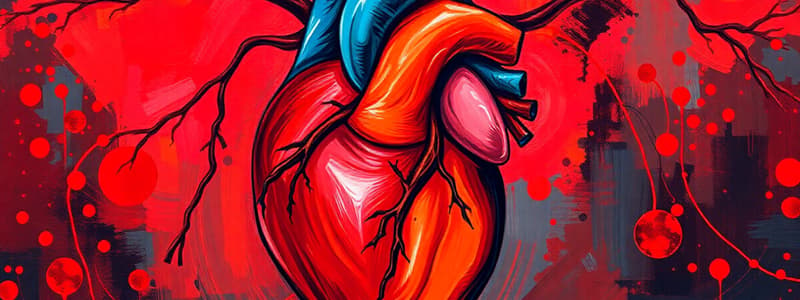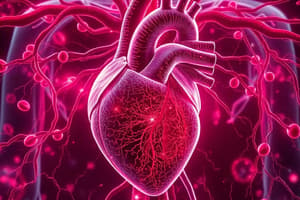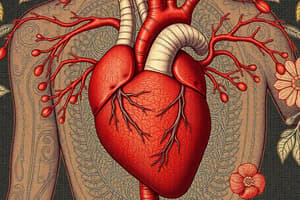Podcast
Questions and Answers
What is the primary function of the atrioventricular (AV) valves during ventricular contraction?
What is the primary function of the atrioventricular (AV) valves during ventricular contraction?
They prevent backflow of blood into the atria.
Describe the role of the semilunar valves in the cardiac cycle.
Describe the role of the semilunar valves in the cardiac cycle.
Semilunar valves close when the ventricles relax to prevent blood from flowing back into the ventricles.
Explain the difference between pulmonary and systemic circulation.
Explain the difference between pulmonary and systemic circulation.
Pulmonary circulation transports oxygen-depleted blood to the lungs, while systemic circulation delivers oxygenated blood to the rest of the body.
What happens to oxygen-depleted blood after it enters the right atrium?
What happens to oxygen-depleted blood after it enters the right atrium?
How do both atria and both ventricles function during the cardiac cycle?
How do both atria and both ventricles function during the cardiac cycle?
What are the primary functions of the cardiovascular system?
What are the primary functions of the cardiovascular system?
Describe the composition of blood and its main components.
Describe the composition of blood and its main components.
What is the role of red blood cells within the circulatory system?
What is the role of red blood cells within the circulatory system?
How are the heart valves categorized, and what are their functions?
How are the heart valves categorized, and what are their functions?
Explain the general structure of the heart and its chambers.
Explain the general structure of the heart and its chambers.
Flashcards
What is the role of the cardiovascular system?
What is the role of the cardiovascular system?
The primary function of the cardiovascular system is to transport nutrients and oxygen-rich blood to all parts of the body and carry deoxygenated blood back to the lungs.
What is blood made of?
What is blood made of?
Blood is composed of blood cells (red blood cells, white blood cells, and platelets) suspended in plasma, the liquid portion of blood.
What is the heart and what does it do?
What is the heart and what does it do?
The heart, a hollow, muscular organ, is responsible for pumping blood throughout the body. It has four chambers: two atria that receive blood and two ventricles that pump blood out.
What are the valves of the heart and their function?
What are the valves of the heart and their function?
Signup and view all the flashcards
What is the flow of blood through the heart?
What is the flow of blood through the heart?
Signup and view all the flashcards
What is the function of heart valves?
What is the function of heart valves?
Signup and view all the flashcards
What are Atrioventricular (AV) valves and where are they found?
What are Atrioventricular (AV) valves and where are they found?
Signup and view all the flashcards
What is the function of semilunar valves?
What is the function of semilunar valves?
Signup and view all the flashcards
Where is the aortic semilunar valve located and what does it do?
Where is the aortic semilunar valve located and what does it do?
Signup and view all the flashcards
Where is the pulmonary semilunar valve located and what does it do?
Where is the pulmonary semilunar valve located and what does it do?
Signup and view all the flashcards
Study Notes
Introduction to the Cardiovascular System
- The cardiovascular system comprises the heart, blood vessels, and blood.
- Its primary function is transporting oxygen-rich nutrients to all body parts and returning deoxygenated blood to the lungs.
- The main components of the cardiovascular system are blood, the heart, and blood vessels.
Blood
- Blood consists of blood cells (red blood cells, white blood cells, and platelets) and plasma (the fluid portion).
- Red blood cells (RBCs) carry oxygen and carbon dioxide.
- White blood cells (WBCs) are part of the immune system.
- Platelets are involved in blood clotting.
- Plasma is largely composed of water, proteins, ions, nutrients, and wastes.
Heart
- The heart is a four-chambered, hollow muscular organ roughly fist-sized.
- It is located superior to the diaphragm, left of the midline, and anterior to the vertebral column, behind the sternum.
- The heart has four chambers: two atria and two ventricles.
- The right atrium receives deoxygenated blood, while the left atrium receives oxygenated blood.
- The right ventricle pumps blood to the lungs, and the left ventricle pumps blood to the rest of the body.
Heart Valves
- Heart valves ensure unidirectional blood flow.
- Atrioventricular (AV) valves (tricuspid and mitral/bicuspid) are between the atria and ventricles, preventing backflow into the atria during ventricular contraction.
- Semilunar valves (pulmonary and aortic) are at the bases of the large vessels leaving the ventricles, preventing backflow into the ventricles during ventricular relaxation.
Pathway of Blood Through the Heart and Lungs
- Deoxygenated blood enters the right atrium, then through the tricuspid valve to the right ventricle.
- The right ventricle pumps the blood to the lungs via the pulmonary arteries.
- Oxygenated blood returns from the lungs via the pulmonary veins to the left atrium.
- Then through the mitral valve to the left ventricle.
- The left ventricle pumps blood through the aortic valve to the aorta, distribution to the rest of the body.
Pulmonary Circulation
- Pulmonary circulation is the portion of the cardiovascular system responsible for transporting deoxygenated blood away from the heart to the lungs and returning oxygenated blood back to the heart.
- This is where oxygen enters the blood, and carbon dioxide leaves the blood.
Systemic Circulation
- Systemic circulation is the portion of the cardiovascular system transporting oxygenated blood away from the heart to the rest of the body and returning deoxygenated blood to the heart.
- It's a much longer process than pulmonary circulation, as it involves transporting blood to every part of the body.
Coronary Circulation
- Coronary circulation is the circulation of blood through the arteries and veins supplying the heart muscle.
- It's the functional blood supply to the heart muscle itself.
Blood Vessels
- Blood vessels form a closed network of tubes.
- Arteries carry oxygenated blood away from the heart.
- Capillaries are the smallest blood vessels for nutrient and gas exchange.
- Veins carry deoxygenated blood back to the heart.
Blood Vessel Structure (General)
- Blood vessels have three layers: tunica intima, tunica media, and tunica adventitia.
Studying That Suits You
Use AI to generate personalized quizzes and flashcards to suit your learning preferences.




